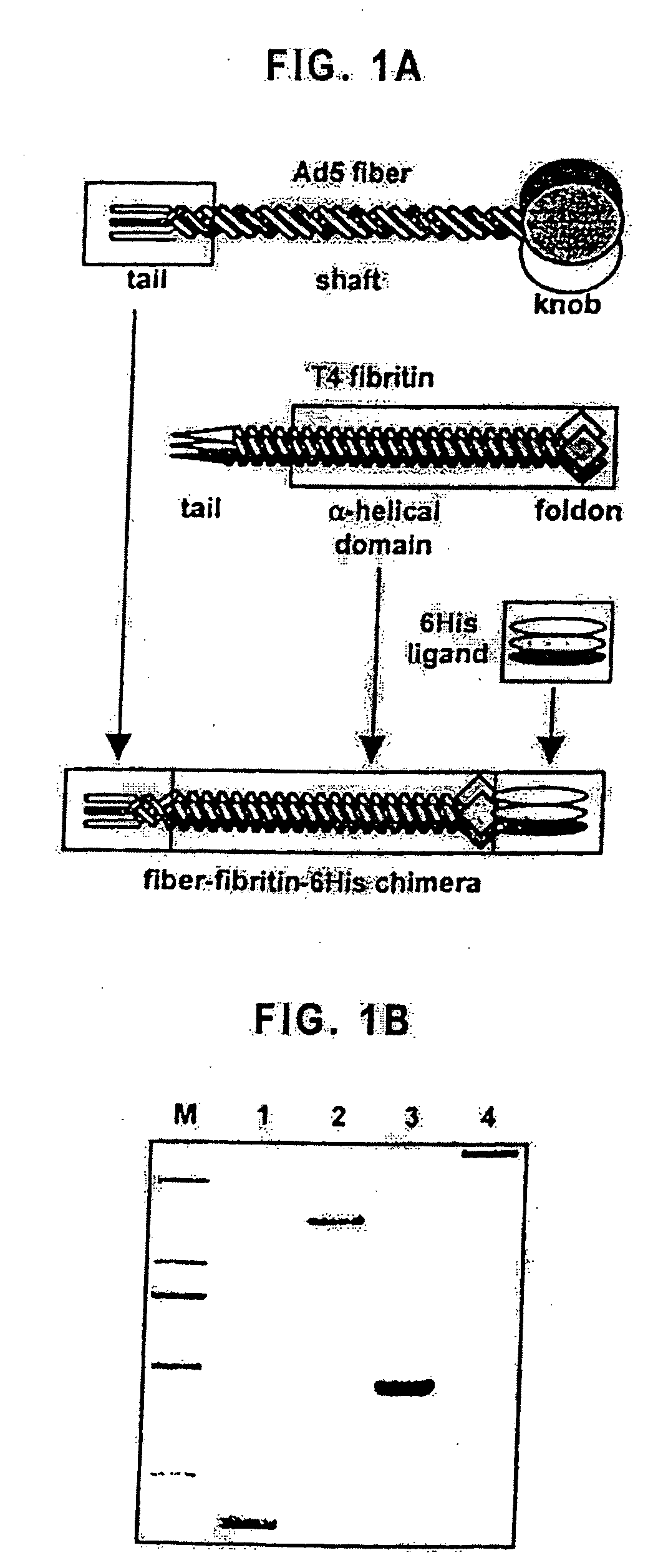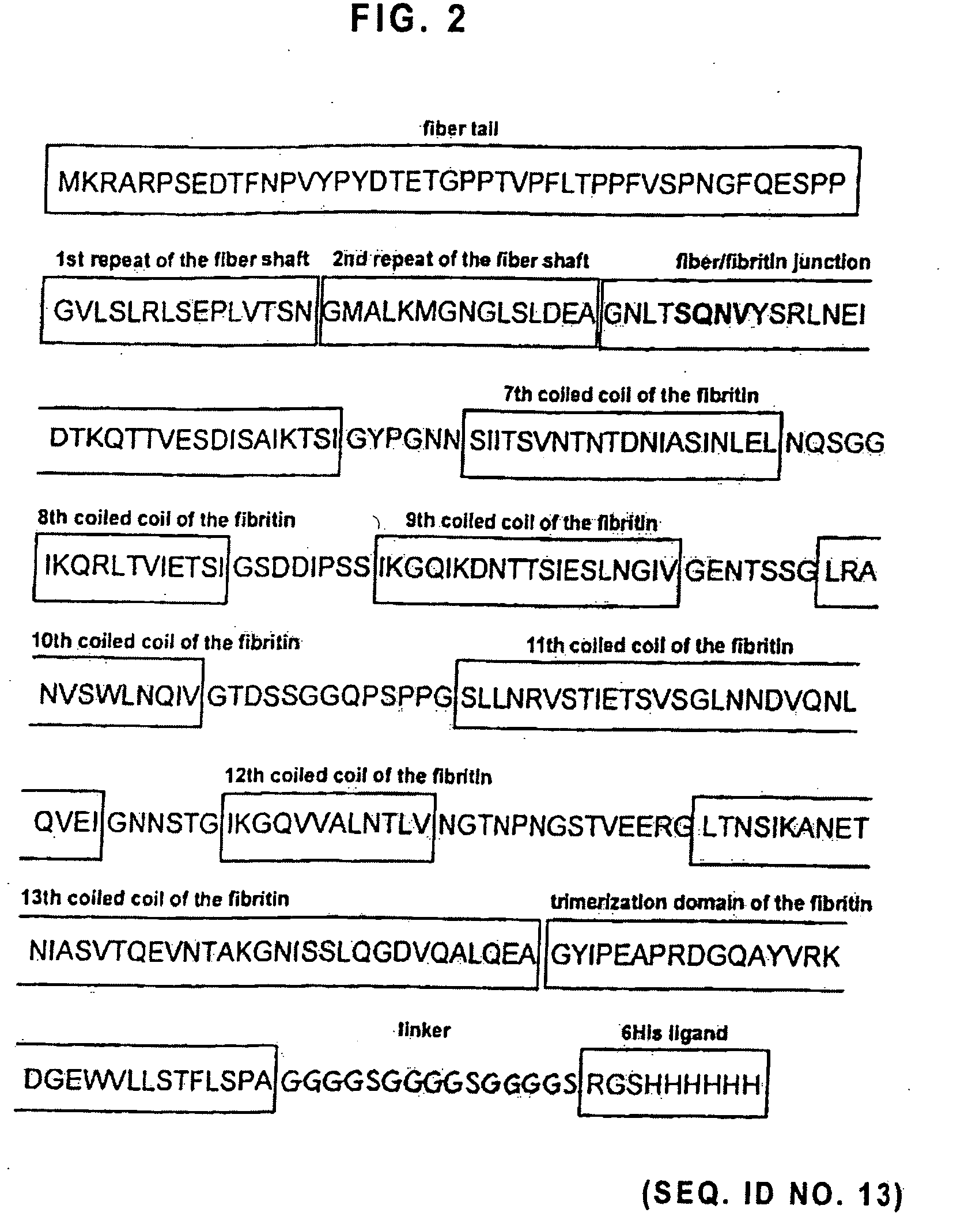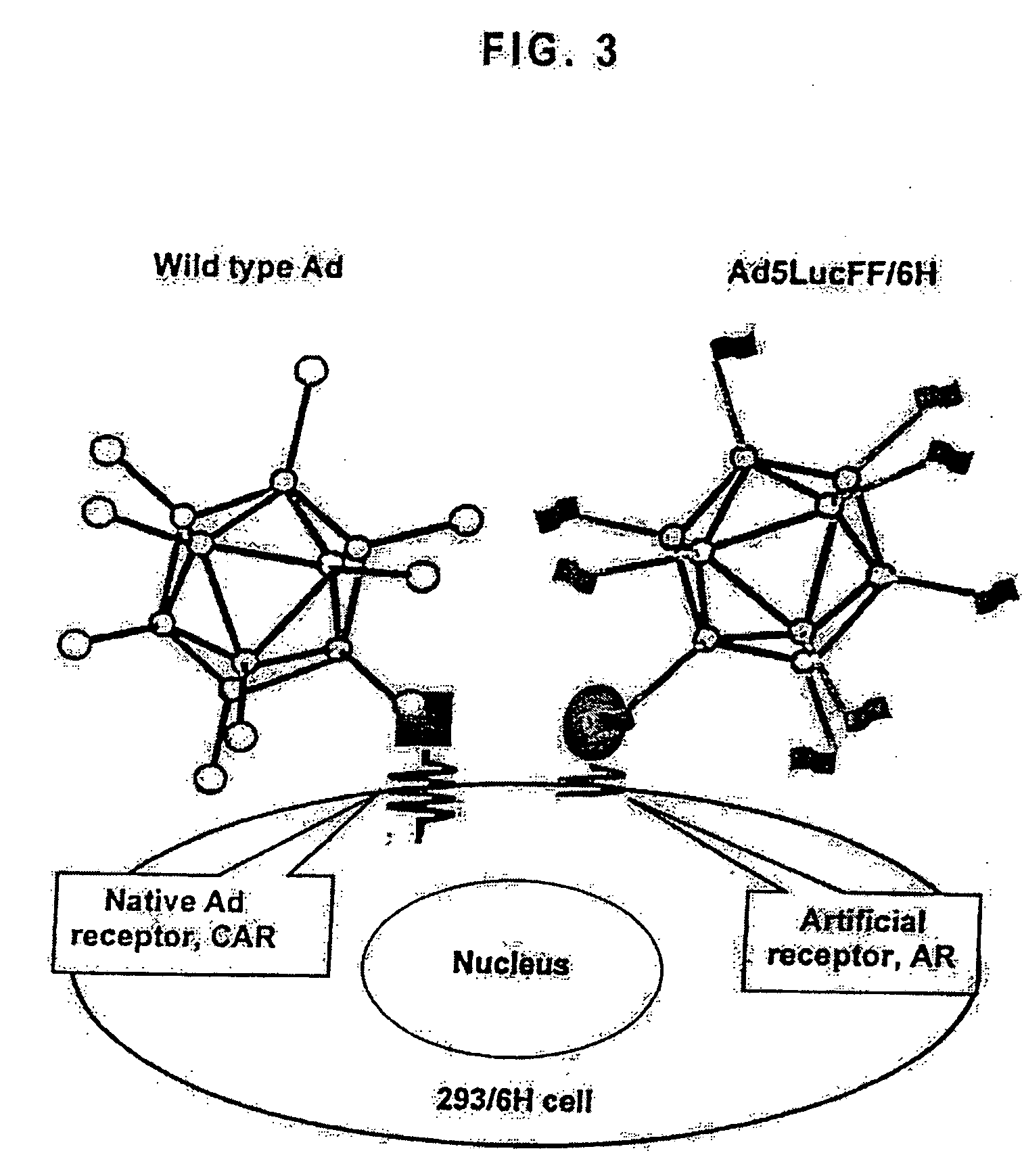Modified adenovirus containing a fiber replacement protein
a technology of fiber replacement protein and modified adenovirus, which is applied in the field of recombinant adenoviral vectors with fiber replacement, can solve the problems of limiting the utility of adenoviral vectors in clinical contexts, mutagenesis or modification of this protein is quite difficult, and the entire molecule is difficult to modify
- Summary
- Abstract
- Description
- Claims
- Application Information
AI Technical Summary
Benefits of technology
Problems solved by technology
Method used
Image
Examples
example 1
Construction of the Fiber-Fibritin-6His (SEQ ID NO: 13) (FF / 6H) Chimera
[0103] Generation of the gene encoding the fiber-fibritin-6His chimera was done in several steps. First, a segment of the fibritin gene was PCR-amplified and used to substitute most of the fiber gene sequence encoding the shaft domain. For this, a portion of the T4 fibritin gene encoding the sixth coiled coil through the C-terminal of the protein was amplified with a pair of primers “FF.F” (GGG AAC TTG ACC TCA CAG AAC GTT TAT AGT CGT TTA AAT G) (SEQ ID NO. 1) and “FF.R” (AGG CCA TGG CCA ATT TTT GCC GGC GAT AAA AAG GTA G) (SEQ ID NO. 2). The product of this PCR encodes a segment of an open reading frame (ORF) containing four amino terminal (GLNT) (SEQ ID NO: 20) and three carboxy terminal (KIG) codons of the fiber shaft sequence fused to the fibritin sequence. The reverse primer introduces a silent mutation at the 3′ end of the fibritin open reading frame resulting in generation of a unique NaeI-site. Also, NcoI-...
example 2
Characterization of Recombinant Adenovirus Expressing the Fiberfibritin-6His (SEQ ID NO: 13)(FF / 6H) Chimera
[0111] For the purposes of preliminary characterization, the FF / 6H chimeric protein was initially expressed in E. coli and purified on a Ni-NTA-agarose column. Subsequent SDS-PAGE analysis of the purified chimeric protein proved that it is trimeric and that the FF / 6H trimers are as stable in an SDS-containing gel as the trimers of the wild type Ad5 fiber (FIG. 1B). Efficient binding of the FF / 6H protein to a Ni-NTA-containing matrix proved that the 6His ligand (SEQ ID NO: 17) was available for binding in the context of this trimeric molecule. According to this analysis, truncated T4 fibritin incorporated into the FF / 6H protein was able to direct trimerization of the chimera and also successfully served the purposes of ligand presentation, thereby satisfying two key functional criteria of an ideal fiber-replacing molecule.
[0112] In order to evaluate the functional utility of t...
example 3
Characterization of Recombinant Adenovirus Expressing the Fiberfibritin-RGD-6His (SEQ ID NO: 13) (FF.RGD / 6H) Chimera
[0121] A second adenoviral vector, Ad5luc.FF.RGD / 6H, containing fiber-fibritin chimeras incorporating at their carboxy termini two peptide ligands RGD-4C (CDCRGDCFC) (SEQ ID NO. 14) and 6His (SEQ ID NO: 17) was generated (FIG. 9). The virus was propagated in 293 cells and purified on CsCl gradient according to standard technique.
[0122] The protein composition of Ad5luc.FF.RGD / 6H was verified by SDS-PAGE using the virus with wild type capsids as a control. As shown in FIG. 10, all major protein components of Ad5luc.FF.RGD / 6H are essentially the same as those of control adenoviral capsid. The only difference noted between the capsid protein patters demonstrated by the two viruses was the presence of the FF.RGD / 6H chimeras in the Ad5LucFF.RGD / 6H particles in place of the wild type fibers contained in the capsids of the control adenovirus.
[0123] FF.RGD / 6H chimeras prese...
PUM
| Property | Measurement | Unit |
|---|---|---|
| molecular mass | aaaaa | aaaaa |
| dissociation constants | aaaaa | aaaaa |
| soluble | aaaaa | aaaaa |
Abstract
Description
Claims
Application Information
 Login to View More
Login to View More - R&D
- Intellectual Property
- Life Sciences
- Materials
- Tech Scout
- Unparalleled Data Quality
- Higher Quality Content
- 60% Fewer Hallucinations
Browse by: Latest US Patents, China's latest patents, Technical Efficacy Thesaurus, Application Domain, Technology Topic, Popular Technical Reports.
© 2025 PatSnap. All rights reserved.Legal|Privacy policy|Modern Slavery Act Transparency Statement|Sitemap|About US| Contact US: help@patsnap.com



